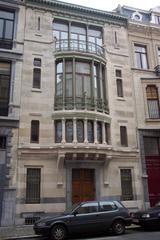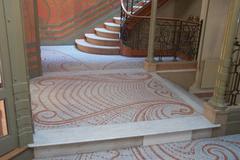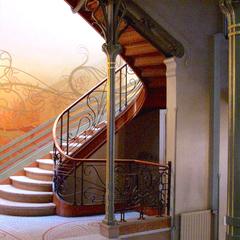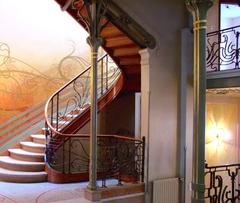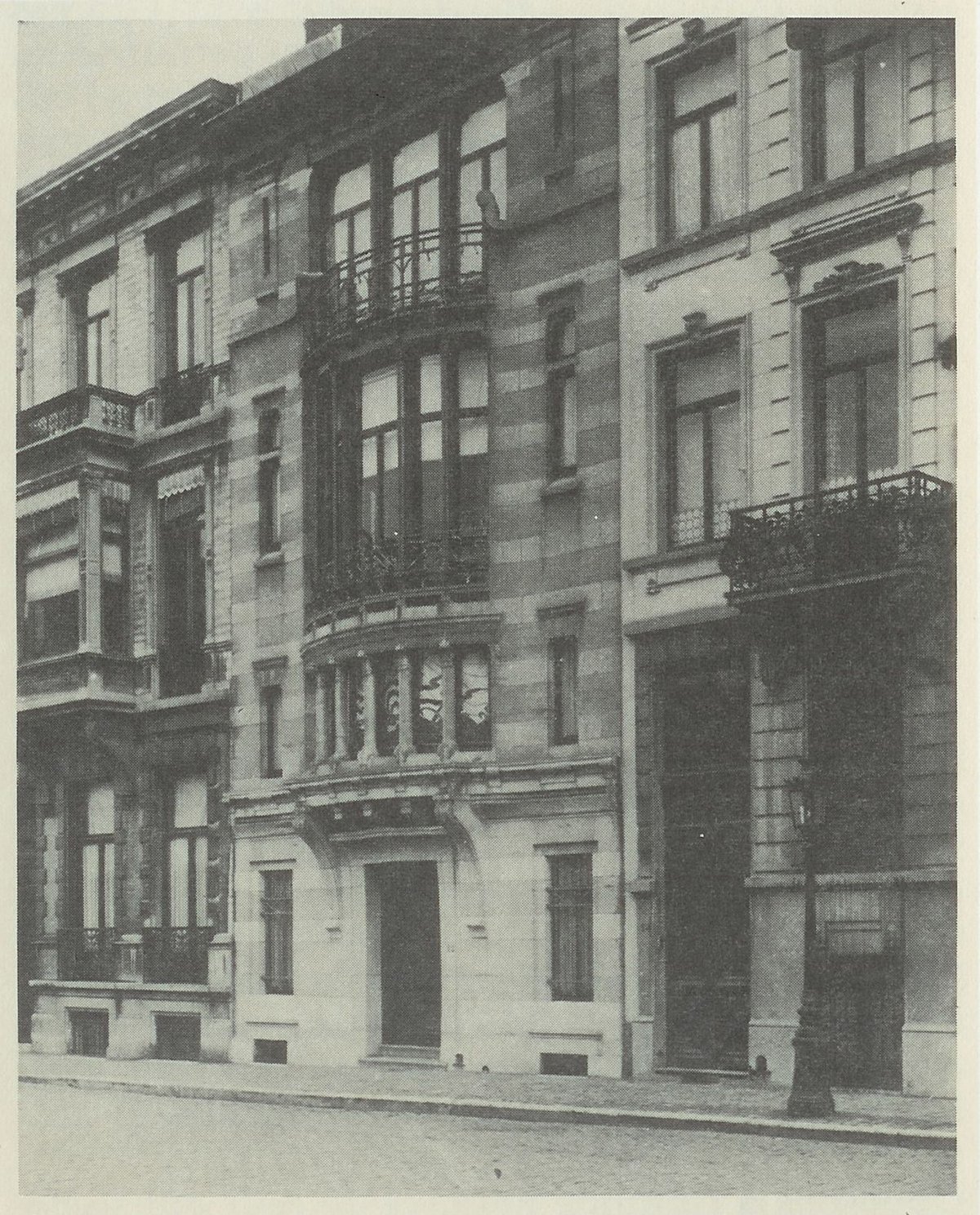
Hôtel Tassel Visiting Hours, Tickets, and Guide to Brussels Historical Sites
Date: 14/06/2025
Introduction
Hôtel Tassel stands as a pivotal landmark in Brussels and is celebrated worldwide as the birthplace of Art Nouveau architecture. Designed by Victor Horta in 1893 for scientist and university professor Émile Tassel, it is a masterpiece that signaled a radical shift in architectural design, integrating organic forms, innovative materials, and a harmony between structure and decoration. Although Hôtel Tassel is a private property with highly restricted interior access, its iconic façade and historical significance make it a must-see for architecture enthusiasts and cultural travelers. This in-depth guide provides essential information on Hôtel Tassel’s visiting hours, ticket options, architectural highlights, accessibility, and travel tips for exploring Brussels’ broader Art Nouveau heritage. For those seeking to delve further, nearby sites such as the Horta Museum and Hôtel Solvay offer complementary insights into Victor Horta’s legacy and the Art Nouveau movement as a whole. To keep up with special events and rare guided tours, consult the official visit.brussels portal and associated heritage organizations. Hôtel Tassel is not just a touchstone in architectural history but also a vibrant symbol of Brussels’ artistic innovation and cultural identity (UNESCO; Planergo; Conservatory Heritage).
Table of Contents
- Introduction
- Historical and Social Context
- Architectural Innovations and Art Nouveau Principles
- UNESCO World Heritage Status and Impact
- Preservation and Accessibility
- Practical Visitor Information
- Nearby Attractions and Travel Tips
- Visuals and Media
- Frequently Asked Questions (FAQ)
- Summary and Travel Tips
- References
Historical and Social Context
From Urban Modernity to Art Nouveau
The late 19th century was a period of rapid urbanization and social change in Brussels. The rising bourgeoisie commissioned homes that reflected their modern and progressive values. Émile Tassel, a scientist at the Université Libre de Bruxelles and a Freemason, desired a residence that could serve as both a home and a venue for intellectual gatherings (visit.brussels). Victor Horta, already an avant-garde architect, was commissioned for the project. Together, Horta and Tassel created a house that broke away from traditional styles and embraced a new, organic architectural language (UNESCO).
Intellectual Exchange and Freemasonry
Both Horta and Tassel were linked to Freemasonry and the scientific community, reflecting the liberal, intellectual, and progressive ideals of the era. The house’s open-plan layout and abundance of natural light were designed to foster creativity and social interaction (visit.brussels).
Architectural Innovations and Art Nouveau Principles
Structural and Spatial Revolution
Hôtel Tassel’s most significant innovation was its open, flowing layout, enabled by an exposed iron framework and large glass elements. Unlike traditional compartmentalized townhouses, Horta’s design allowed for seamless transitions between rooms and filled the interior with natural light via skylights and a central glass canopy (Planergo). The sculptural central staircase, illuminated by overhead glass, became the symbolic heart of the home.
Decorative Arts and Symbolism
Horta’s holistic approach extended to every detail, from custom furniture to ironwork, mosaics, and stained glass—all featuring the signature whiplash lines and botanical motifs of Art Nouveau (Conservatory Heritage). These organic forms, inspired by nature, are woven throughout the building, uniting structure and decoration in a “total work of art” (Gesamtkunstwerk) (Lalerou).
Material Innovation
The use of iron columns, glass roofs, and mosaic floors was not only structural but also aesthetic, creating an unprecedented sense of transparency, lightness, and modernity (Planergo; Lalerou).
UNESCO World Heritage Status and Global Impact
In 2000, Hôtel Tassel, together with three other Horta townhouses (Hôtel Solvay, Hôtel van Eetvelde, Maison & Atelier Horta), was inscribed as a UNESCO World Heritage Site. UNESCO recognized these buildings as “outstanding examples of Art Nouveau architecture” and as “works of human creative genius” (UNESCO). Hôtel Tassel’s design inspired architects across Europe, including Hector Guimard in Paris, and influenced the spread of Art Nouveau to cities like Vienna and Barcelona (wikipedia).
Preservation and Accessibility
Hôtel Tassel is a private property, currently used as an office for the European Food Information Council (EUFIC), and does not offer regular public access. However, its UNESCO status ensures active preservation efforts. Occasionally, the building is included in special events such as Brussels Heritage Days and the BANAD Festival, when limited guided tours may be available (BANAD Festival; Arau).
For ongoing preservation, restoration projects focus on maintaining the original materials and design integrity. Visitors interested in Horta’s work can access the nearby Horta Museum, which is open to the public year-round (visit.brussels).
Practical Visitor Information
Location
- Address: Rue Paul-Émile Janson 6, 1000 Bruxelles, Belgium (visit.brussels)
- Neighborhood: Ixelles, close to Avenue Louise, a central and vibrant district
Getting There
- Metro: Louise station (Lines 2 and 6), 5 minutes on foot
- Tram/Bus: Multiple lines serve the area; stops at “Bailli” and “Porte de Namur” are nearby
- Taxi/Rideshare: Readily available throughout Brussels
- Accessibility: The exterior is viewable from the public street, which is accessible for visitors with limited mobility
Visiting Hours & Tickets
- Interior Access: Hôtel Tassel is not open for regular interior visits. The exterior can be admired at any time.
- Special Events: Rare opportunities for interior access may occur during Art Nouveau Days or the BANAD Festival. These events require advance booking and tickets; check official tourism or event websites for details (BANAD Festival).
- Guided Tours: Organizations like Arau and Pro Velo offer walking and cycling tours that include Hôtel Tassel’s façade and nearby Art Nouveau landmarks (Arau).
Photography
- Exterior: Permitted from the public street
- Interior: Generally prohibited during special events or tours
Nearby Attractions and Travel Tips
Art Nouveau Highlights
- Hôtel Solvay & Hôtel van Eetvelde: Other Victor Horta masterpieces, occasionally open for tours
- Horta Museum: Offers extensive insight into Horta’s life, philosophy, and works
- Avenue Louise: Lined with shops, cafés, and further Art Nouveau architecture
- Place du Châtelain: A lively local square with markets and dining options
Accommodation & Dining
- Steigenberger Wiltcher’s: Upscale hotel on Avenue Louise (Miss Tourist)
- Ibis Brussels Centre: Budget-friendly, modern option
- Dining: Explore Sablon or Châtelain for authentic Belgian cuisine. Pierre Marcolini in Sablon is recommended for chocolate lovers (Miss Tourist).
- Travel Tip: Avoid touristy dining spots like Rue des Bouchers; opt for local favorites (Happy to Wander).
Visuals and Media
For an enhanced appreciation of Hôtel Tassel, consult high-quality images and virtual tours available on official tourism and heritage websites. Use descriptive alt text such as “Hôtel Tassel Art Nouveau façade in Brussels” for accessibility and search optimization.
Frequently Asked Questions (FAQ)
Is Hôtel Tassel open to the public?
No, Hôtel Tassel is a private property and is not generally open for interior visits.
How can I visit Hôtel Tassel?
You can admire the façade from the street at any time or join an Art Nouveau walking/biking tour that includes the exterior. Special interior visits may be possible during specific cultural events.
Are tickets required for Hôtel Tassel?
No tickets are needed to view the exterior. Tickets are required for rare special tours or events.
Is Hôtel Tassel accessible for wheelchair users?
The sidewalk and street are accessible. Interior access is not currently available.
What are the best times to visit?
Spring and autumn offer pleasant weather and coincide with many cultural events, including Art Nouveau Days.
What nearby attractions are recommended?
The Horta Museum, Hôtel Solvay, Hôtel van Eetvelde, Avenue Louise, and Place du Châtelain—all within walking distance or accessible by public transport.
Summary and Travel Tips
Hôtel Tassel is a foundational work of Art Nouveau and a testament to Victor Horta’s visionary approach to architecture. Its innovative use of iron, glass, and organic motifs transformed late-19th-century design and influenced modern architecture globally. As a private property with limited interior access, Hôtel Tassel invites visitors to appreciate its exterior and to explore Brussels’ broader Art Nouveau heritage through guided tours, related museums, and cultural festivals. For optimal enjoyment, plan your visit during major Art Nouveau events, combine your itinerary with other Horta landmarks, and consult official tourism resources for updates on special access and tours. Hôtel Tassel remains a beacon of creativity, innovation, and cultural legacy in Brussels (UNESCO; Arau; BANAD Festival).
References and External Links
- visit.brussels – UNESCO World Heritage in Brussels
- visit.brussels – Art Nouveau Houses and Mansions
- Conservatory Heritage – The Hôtel Tassel
- Planergo – Hôtel Tassel
- Lalerou – Hôtel Tassel
- Triphobo – Hôtel Tassel
- Wikipedia – Hôtel Tassel
- UNESCO World Heritage Listing for Hôtel Tassel
- BANAD Festival
- Arau – Urban Research and Action Workshop
- Miss Tourist – Where to Stay in Brussels
- Happy to Wander – Brussels Travel Tips
Image suggestion: Feature a high-quality photo of Hôtel Tassel’s Art Nouveau façade with alt text “Hôtel Tassel Art Nouveau façade in Brussels”. Consider embedding an interactive map for visitor convenience.

